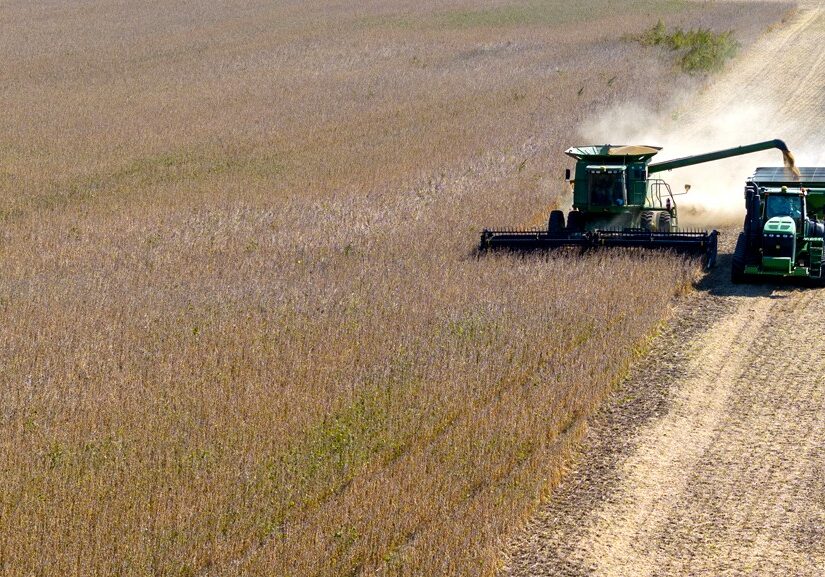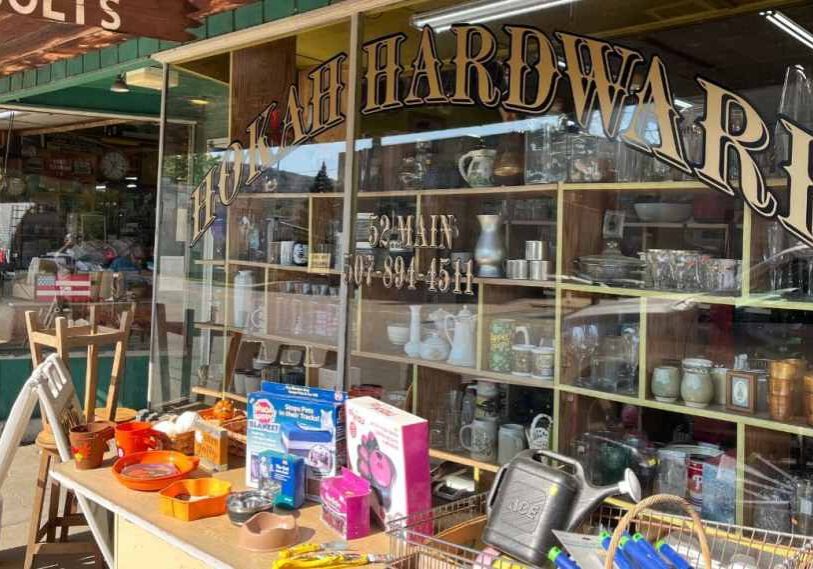LeRoy-Area Couple Turns Family Dairy Farm into Gourmet Mushroom Business

BEAVER TOWNSHIP/FILLMORE COUNTY — Kalvin Stern and Rachel Davis grew up near LeRoy and both had a vague idea they would eventually end up involved in some type of growing or farming after college.
It wasn’t until a series of coincidences—an unusual discovery while playing disc golf in Stevens Point, Wis., a move to the mountains of North Carolina in a city with a thriving local foods scene and the opportunity to purchase the farm of Rachel’s great grandparents—that they would end up operating a mushroom farm.
The couple started Fiddlehead Knob, located in the southwestern corner of Fillmore County directly south of Spring Valley and east of LeRoy, in 2017. The gourmet mushroom business started in the basement of the 1904 home located on the Davis family farm, now in its fourth generation of operation, but soon moved to a shed on the property and has been expanding ever since.

Solar panels have been installed where the cattle yard was located when the farm had dairy cows. There is another row of panels behind this one as mushroom farming uses a lot of electricity. (Photo by David Phillips)
After installing solar panels in the summer of 2023 to become fully powered by the sun, the operation in 2024 received its organic certification, tripled the size of the grow room, added a large walk-in cooler and rebranded its marketing. The couple is seeking to build on that recent success with several more ideas for growth.
Full circle back to LeRoy
The two attended college at the University of Wisconsin-Stevens Point where they started foraging in 2012, something that interested them as a hobby at the time, but it was also a practical pastime as they tried to make ends meet as students.
“I was out playing disc golf one day and found some cool-looking mushrooms and I thought they looked gorgeous and wanted to know more about them, so I bought a book on foraging,” said Kalvin.
He had always loved wild food, he said, but he grew up hunting, not foraging, so he didn’t know much about it at first. Once he learned more, he started foraging with a purpose and fell in love with it, he said.
After they graduated from college, the two moved to the Appalachian Mountains community of Boone, N.C., which Kalvin said had a “vibrant local foods scene.” He worked at an organic and biodynamic farm while Rachel worked at a homeless shelter with a food pantry. The pantry had a commercial kitchen that Rachel worked in at times while Kalvin got involved with the local farmers market. These experiences inspired them to follow a dream of growing and sharing food with the community.
“We fell in love with local food,” said Rachel. “We kind of had always known we wanted to something involving farming or a farmstead, but we didn’t know exactly what that would be.”

Kalvin Stern and Rachel Davis enjoy foraging with their two daughters, Eliza and Veda. (Photo by Rachel Davis)
During the two years they lived there, Kalvin was offered some space for trial-and-error growing projects. That gave him some experience growing different foods. Although he could have focused on vegetable farming, which is what he primarily worked on in North Carolina, he veered more toward mushrooms to coincide with his foraging interest and because it is a less common specialty that would provide a niche for them to thrive.
The two were married in the fall of 2016 and moved back to the LeRoy area family farm in December 2016, renting at first before purchasing the 10-acre farmstead, which had been primarily a dairy farm in the past.
Continual expansion surges in 2024
The first mushroom farm that operated out of the basement of the farm home was adequate as the basement was cool, but the couple soon wanted something larger and more accessible. They insulated a shed on the farm property and moved the operation there, although it remained a side occupation at first as Kalvin worked as a carpenter and Rachel worked for a nonprofit organization in Rochester.
Still, the mushroom farm was a focus of the couple as they continued to tinker while also expanding the operation.
“It’s a learning process—just like conventional farming or vegetable farming, you try something and then you think we could do better,” said Rachel.
“We made a lot of mistakes,” added Kalvin. “We definitely didn’t know what we were doing on the business side.”
The learning paid off as the couple decided to refocus their lives primarily on the mushroom farm in 2022. They eventually quit their off-site jobs to work full-time with mushrooms.
Since they moved back to the LeRoy area, they have had two girls, Eliza and Veda, with a third child on the way this January—they even get their children involved in the operation to make it a true family farm.
Mushroom farming can be difficult to envision
The expansion is demanding and has been continual since they arrived back in Minnesota. Rachel pointed out that Kalvin has used his carpentry experience to build five grow rooms, two in the basement and three in the shed, each one providing more room for growing mushrooms.
When the couple told Rachel’s grandparents, who managed the family farm and still live nearby, that they wanted to grow mushrooms, they were a little “uncertain” at first, but they have always been fully supportive of their goal, said Rachel. Like other people, it took them a while to understand what it really meant to have a mushroom farm, she explained.

Three of the mushrooms grown at Fiddlehead Knob are, from left, lion’s mane, blue oyster and chestnut. (Photo by David Phillips)
“A lot of people don’t understand really what it means,” said Rachel. “They have this vision in their heads and when they come see it, they say, ‘whoa that isn’t anything like I envisioned.’
“At farmers markets we talk to a lot of customers and people have different impressions, such as ‘oh, you must grow these in the dark, like in a cave,’ and we say, ‘no they actually have a lot of humidity and a lot of light.’”
Assembling a mushroom grow room
The grow room, which is the hub of the operation, is bright and clean with constantly moving air. The LED lights, which are similar to ones used for other plants, are on 12 hours each day. The grow room is spot cleaned each day with a thorough cleaning once a week, something Kalvin said is necessary to maintain quality as well as its organic certification.
The room is just 12- by 20-feet long, or 240 square feet, yet the couple produces about 200 pounds of fresh mushrooms a week. The mushrooms grow in blocks of wrapped substrate, which is composed of sawdust and organic soybean hulls, placed on racks with several shelves. The couple rolls the racks into the production room for harvesting. The harvested mushrooms go into a large walk-in cooler.
The solar power system installed in the summer of 2023 paved the way for the expansion in the summer of 2024 since the operation is heavily dependent on electricity. The solar panels, located in what was once the cattle yard, power the business and home.
The couple recently installed a new cooling system, which keeps the growing temperature at about 60 to 61 degrees year-round. The cooling system for growing is a big challenge in mushroom cultivation. Mushrooms grow rapidly, producing a large amount of heat at once, so they could possibly cook themselves if the air isn’t cooled.
In addition to the cooling system, a new high pressure misting system was recently installed to help keep the grow room at the proper relative humidity, usually around the 80 percent mark. Water runs through a softener unit and is then pre-filtered before going through an ultraviolet sterilizer bulb to kill any bacteria “so it’s really nice, clean water we have running through there, which is really important in mushroom production,” said Kalvin. The constant bursts of mist are all the water mushrooms need to grow.
Growing mushrooms is a complex process that starts with a little syringe of a liquid culture inoculated into rye grain, which starts a grain spawn that is eventually inoculated into the substrate. Incubation takes several more weeks. Start to finish, the growth cycle is about a month-and-a-half to two months.

Kalvin Stern and Rachel Davis with their stand at the 2024 FEAST! festival in Rochester, Minn. (Photo by John Torgrimson)
“Once we get on a weekly schedule, we’re cranking mushrooms out every day,” said Kalvin. “They never stop growing—and the mushrooms themselves, once they start growing, double in size every day.”
Due to the rapid growth, they are harvesting most days. They even have cameras in the grow room to help monitor when to harvest because they grow so fast.
This winter, the couple is growing lion’s mane, which have a fuzzy, white covering; blue oyster mushrooms, in which the caps turn a pretty shade of deep blue when mature; chestnut mushrooms, with a cinnamon red cap; and black pearl oyster mushrooms, which have a dark cap. The lion’s mane and blue oyster mushrooms are “our bread and butter” varieties, said Kalvin. They grow more varieties in the summer during prime market season.
The primary market for their mushrooms is farmers markets, particularly Rochester and Decorah, but they also sell to area restaurants.
Eye to the future
With the rapid expansion in 2024, Fiddlehead Knob is in a slower phase now during the winter, but there are still many things in the works with plans for more expansion ahead.
The couple is continuing to work on a shiitake mushroom yard and several outdoor raised beds. Kalvin said they would like to have some permaculture-style gardening and other types of gardening throughout the seasons.
They also have a hydrator for dry products. Any oversupply is dried down and put in bags and packaged as a forager blend, which is a combination of their mushrooms. They are sold at the markets now, but the couple would like to expand distribution.
The graphic designer that did the logo rebrand is also working on some custom packaging to help get these into commercial establishments as well, said Rachel.

Some of the value-added products Kalvin Stern and Rachel Davis sell at farmers markets and hope to eventually sell in local shops. (Photo by David Phillips)
“We do the fresh mushrooms, but we’d like to do the value-added stuff, too,” said Rachel. “We only sell these at markets right now, but we’re working on getting them into stores down the road.”
Some of the value-added products they have include mushroom garlic salt, mushroom chocolate chive and a mushroom tea. They are also considering a mushroom jerky.
They will probably never sell fresh mushrooms in stores because they can’t control how they look to customers. They harvest their mushrooms carefully to not break anything and also package them carefully.
“We definitely pride ourselves on the presentation of it all,” said Kalvin. “They’re beautiful, taste delicious and it’s a premium product, so we want to make them look good.”
One thing that has set up the couple for success is participation in the Rural Business Innovation Lab offered by Community and Economic Development Associates (CEDA), a private, nonprofit organization based in Chatfield that serves southeastern Minnesota and beyond. The lab is an entrepreneurial development program that focuses on rural innovative businesses.
“We got weekly one-on-one business coaching and someone to bounce our ideas off of,” said Rachel. “We have so many ideas, which is one of the fun parts of running your own business. But we have a hard time sometimes focusing on one path.”
She pointed out that the representatives they met with during the eight months of free consulting were good at narrowing the focus with deadlines, schedules and plans.
“They were just great,” Kalvin agreed.
Still, despite focusing more on specific goals, the two have plenty of ideas to consider. Rachel said some of her dreams are to offer more education such as workshops and classes, host on-farm dinners, install a commercial kitchen, hold foraging walks and put in a small on-farm store.
Those may be dreams now, but that is what got these two rural entrepreneurs going in the first place.
“It was always kind of our dream, even when we were in North Carolina—we were like, how to raise a family on the farm and how are we going to do that without one of us working off the farm,” said Kalvin. “It took a long time, but we got here.”
The Fiddlehead Knob website is both informative and entertaining, including stories on its Mushroom Musings blog. Many of Fiddlehead’s products can be ordered online. You can stay up to date on Fiddlehead Knob news through its quarterly newsletter (subscribe on its website) or visiting the Fiddlehead Knob Facebook page. Fiddlehead Knob Farm was among several regional producers featured at the 2024 FEAST! Festival in Rochester. Learn more in this Root River Current article.






